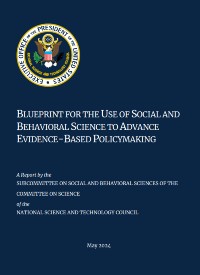Diving Into OSTP’s ‘Blueprint’ for Using Social and Behavioral Science in Policy
UPDATE on JANUARY 23: Links to the Blueprint on the White House website have been removed and do not redirect to an archive. This post now links to an archived version at digitalgovernmenthub.org.
“[M]ost earlier discussions of ‘the utilization of research in decision-making’ founder on conceptual ambiguities in all three terms – utilization, research, and decision-making. Each of the concepts is more complex than most of us imagine.”– Carol H. Weiss (from the preface to Social Science Research and Decision-Making, 1980)
Just in time for this past summer’s reading list, in May 2024 the White House Office of Science and Technology Policy (technically, the National Science and Technology Council’s Subcommittee on Social and Behavioral Sciences of the Committee on Science) published The Blueprint for the Use of Behavioral and Social Science to Advance Evidence-Based Policymaking. Representatives from a wide range of government agencies and White House offices had input into the report and provided a set of case studies featured in its appendices. Here I offer a brief but close reading of the report and offer an understanding what it means by “social and behavioral science” its “use,” and “policymaking.”
For social and behavioral scientists, this report is pathbreaking in multiple ways. While preceded by previous reports (see here, here, and here) that focus on and promote the use of research in policy decisions, the Blueprint may be the first produced by an executive branch body specific to social and behavioral science (SBS) and its relevance. Notably, while the emergent field of evidence-based policymaking (EBP) has concentrated on how academically based social scientists can better generate and disseminate research that is usable in policy circles, the Blueprint’s principal audience is government agencies. Rather than a how-to for researchers who seek impact, it is a resource for public servants who want to (or should want to) better use SBS. Consistent with the Biden administration’s broader priorities, it emphasizes how SBS research can be useful to achieve equity as well as efficiency.
The Blueprint also reveals how much social science capacity and insight exist within the federal government, something many academics may not be aware of. At the same time, it foregrounds certain kinds of policy decisions for which SBS is useful and gives less attention to other kinds, especially those involving policy agenda-setting and/or where political considerations condition whether and how SBS knowledge is used. To some degree, this surely reflects what can be talked about in an official document.
How is SBS characterized in the Blueprint? The document presents a broad and open-ended version of the field and argues that multiple methods and disciplines are relevant to EBP. Not only data and causal arguments, but also SBS conceptual frameworks and researchers’ relationships with those “researched,” matter. This catholic (with a small c) version of SBS considers both behavioral and structural approaches as valuable to the work of government agencies, although at times the report foregrounds behavior and behavior change as SBS’ ultimate focus. For example:
Elsewhere, the report refers to “the complex processes that govern how people and societies think and act in practice”(p. 9) and “the pathways through which even indirect factors (e.g. institutional, historical, community) can result in any number of important outcomes …” p. 15, emphasis added)
Thus, while “structure” is rarely invoked directly, the report frequently emphasizes social, historical, and cultural “contexts” or “environments” alongside references to ostensibly strong causal approaches (e.g. randomized control trials), nudge-type thinking, user-design, and the evaluation of “what works.” In part, the gestures toward social structure and collective action may reflect the substantial weight the Blueprint gives to equity in the design and implementation of government programs for which SBS has a role.
The juxtaposition of behavior and context – and of policies focused on both changing people and changing environments – is not all contradictory. The Blueprint explicitly argues that “phenomena that occur within the person” (e.g. cognition, emotion, … and “around the person”(e.g. economic conditions, policy, culture, …) are mutually constitutive:
Next, the Blueprint is broad in terms of the kinds of “uses” to which SBS can be put. This ranges from designing, testing and evaluating interventions to providing deep knowledge of context of communities and potential program beneficiaries. The report also strongly emphasizes that improved use of SBS requires purposeful attention to knowledge access –especially for government agencies and decision-makers but also for citizens involved in government programs. It highlights efforts to synthesize existing knowledge and build data infrastructures and information clearinghouses.
In the Blueprint’s appendices, a substantial number of examples and case studies focus on communication and “community engagement” – i.e. how to increase the number of people aware of, participating in, and benefiting from government programs. The role of government in reducing vulnerability to risk – whether related to hazard exposure or to recidivism in the case of the previously incarcerated – is one common way in which the Blueprint highlights the usability of SBS. While the most frequently cited uses involve improving awareness of risk itself or of government programs to mitigate it (often through experimental research, user design studies and/or direct research partnerships with communities and their members), the Blueprint also points to the “practical value” of SBS in defining and conceptualizing risk.(e.g. p.51) The implication is that SBS can provide not just evidence but ways of thinking about how the world works.
Lastly, the kinds of policymaking for which the report sees SBS as usable encompasses a wide range of areas – digital access, criminal justice, workforce participation, health outcomes, infrastructure, and security. As to be expected in a report principally reflecting the experiences of government agencies, the scope of decision-making it discusses takes place within the framework of broad policy decisions already articulated by the Biden administration. The “policymaking” that SBS can inform is directed to the design and implementation of decisions within the purview of the agencies’ mandate.
As mentioned, the Blueprint is rich with examples at this level of policymaking, especially around engagement and communication. The report does gesture at times at how SBS can also be usable at the agenda-setting level of policymaking, but that is not, nor is intended to be, the principal focus. SBS research relevant to the formulation of policies to redress structurally-derived inequalities or to designing legal and political frameworks, or to enhance equity or political participation, for example, are more alluded to than discussed. To return to the Blueprint’s emphasis on the use of SBS in relation to health and environmental risks (but also the risk of recidivism), policies of risk communication and mitigation of risk exposure dominate the examples. Policies aimed at reducing the risk itself (e.g. the existence of an environmental hazard or incarceration policies that create the risk of recidivism) are largely outside the frame of the report.
Of course, the role of SBS at the policy agenda-setting level is typically murky. Many other factors besides evidence, not least political ones, shape policymaking – in ways both necessary for democratic practice but that also make the use of evidence and expert knowledge highly contingent and sometimes highly politicized.
This is a point made by previous generations of what we now might call EBP analysts (e.g. Charles Lindblom [for example, here and here], Carol Weiss [for example, here and here]) and which is beginning to be resuscitated as the limits of more technocratic versions of EBP become clear (among many examples, see here, here, and here). The SBS imagination of the Blueprint’s authors is particularly evident in those places where they acknowledge other influences on decision-making. In arguing for the important of bringing together current and often disparate forms of SBS evidence and approaches, the Blueprint adds that the synthesis “should also seek to identify both gaps in existing knowledge, as well as important boundary conditions and contexts that currently constrain the applicability of the evidence.”(p.15, emphasis added)
In this subtle way, the Blueprint states its own boundary conditions, making a pragmatic nod to how social and political structures and processes, and inequalities in the ability to influence decisions, inevitably shapes policymaking at a range of levels. Indeed, one wishes for a sequel to the Blueprint in which those who have worked on the “inside” address the boundary conditions and contexts under which SBS can have impact, not least on the broad policy frameworks within which government agencies operate. For that, we may need to wait until some of the Blueprint’s contributors are no longer in public service.






























































































